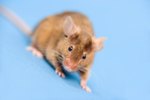
Hairless rats are exactly like their furred siblings, save the fact that they happen to have little to no hair. Also known as nude or Sphinx rats, these wrinkly naked rodents are more accepted in the United States than Europe as a rat variety. Their skin can come in the same colour variations as furred rats; the genetic variable is their dominant rex trait.
Double Rex

Double rexes are the most common of the hairless varieties. The double rex is completely bald, with very short curly whiskers. Some double rexes may have small patches of fur on their face and ankles. The double rex can be in a variety of "colors", and can sport standard top ears or dumbo ears. The term "double rex" can be confusing, as patchwork rats are also born of two rex parents, and can boast double rex genes.
Patchwork Hairless
Patchwork hairless rats, born from two parents of the rex variety, are a mixture of bald and furred. As they grow, their hair will consistently fall out, only to grow back in a new spot. Patchwork rats do not experience pain from their hair falling out, which happens around once every week. Like their double rex siblings, patchwork rats can come in every standard color and ear type. When the patchwork hairless rat's fur does come in, it will be curly, just like a regular rex rat.
Truly Hairless
Truly hairless rats are rarely seen as a domesticated pet. These rats, bred for science experiments, do not have a single hair on their body -- not even whiskers. Truly hairless rats also miss a portion of their immune system, the thymus gland. Because of this, they are prone to upper respiratory, kidney, liver and bacterial diseases. While the lifespan of most rats is two to three years, the lifespan of a truly hairless rat is nine to twelve months.
Caring for Your Hairless Rat
As one would imagine, hairless rats require more options to warm themselves than their furry siblings. A hairless rat should not be kept alone in a cage, but instead should be accompanied by a second rat for warmth and stimulation. Hairless rats also benefit from increased protein in their diets as the energy spent to keep their bodies warms up their metabolism. Their bare bodies are also susceptible to allergens and irritations from bedding. Use chemical and toxin-free bedding, and eschew pine or cedar shavings, as these can trigger respiratory issues.
References
Resources
Photo Credits
-
Jupiterimages/Photos.com/Getty Images



